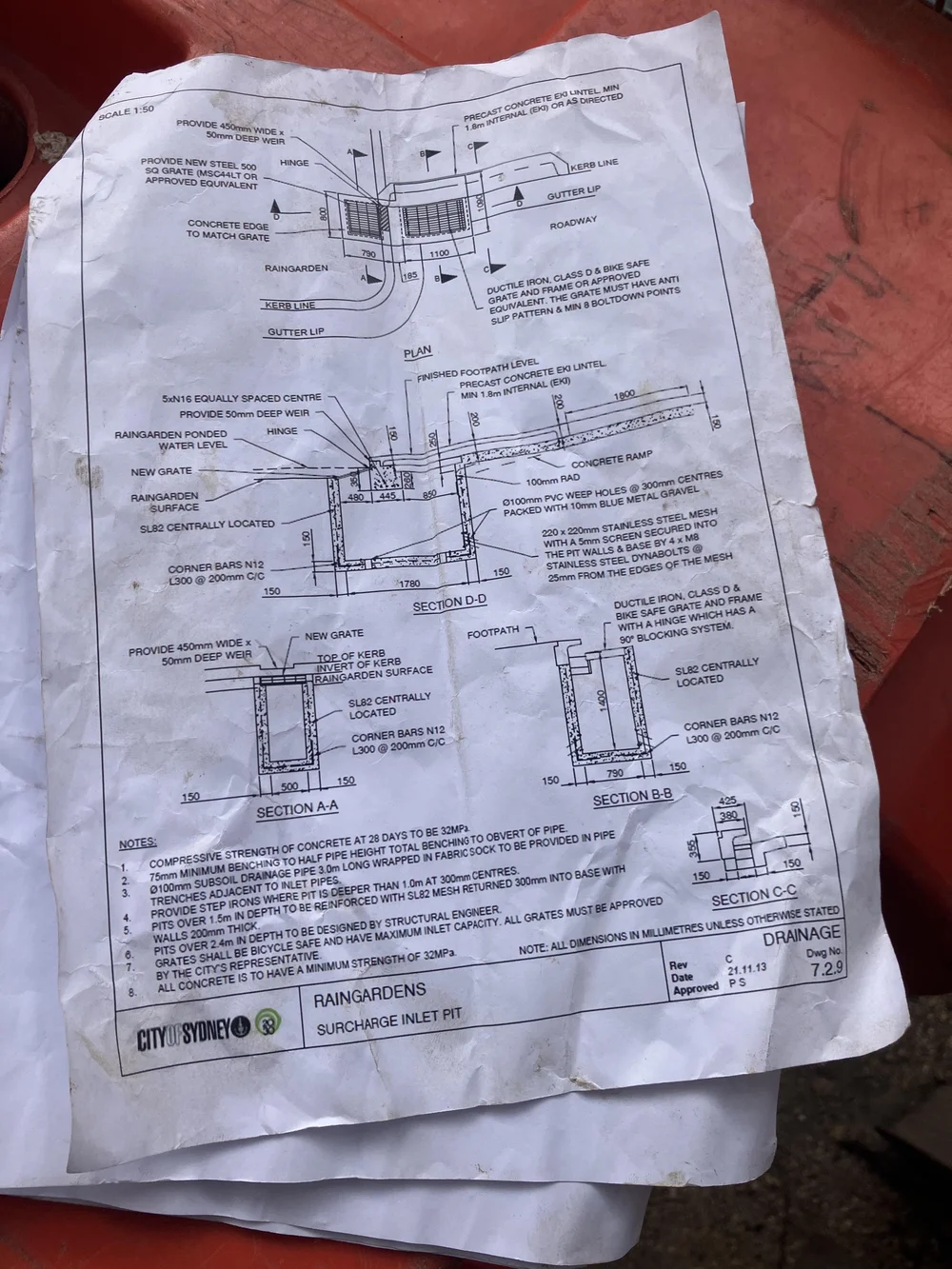• July 2025 – Concrete pour around pit with six pipes at base of pit – hessian sacks in pipes are to prevent concrete blocking the pipes; the pipes are intended to discharge rain to soil about 1 metre below the surface of the ‘rain garden’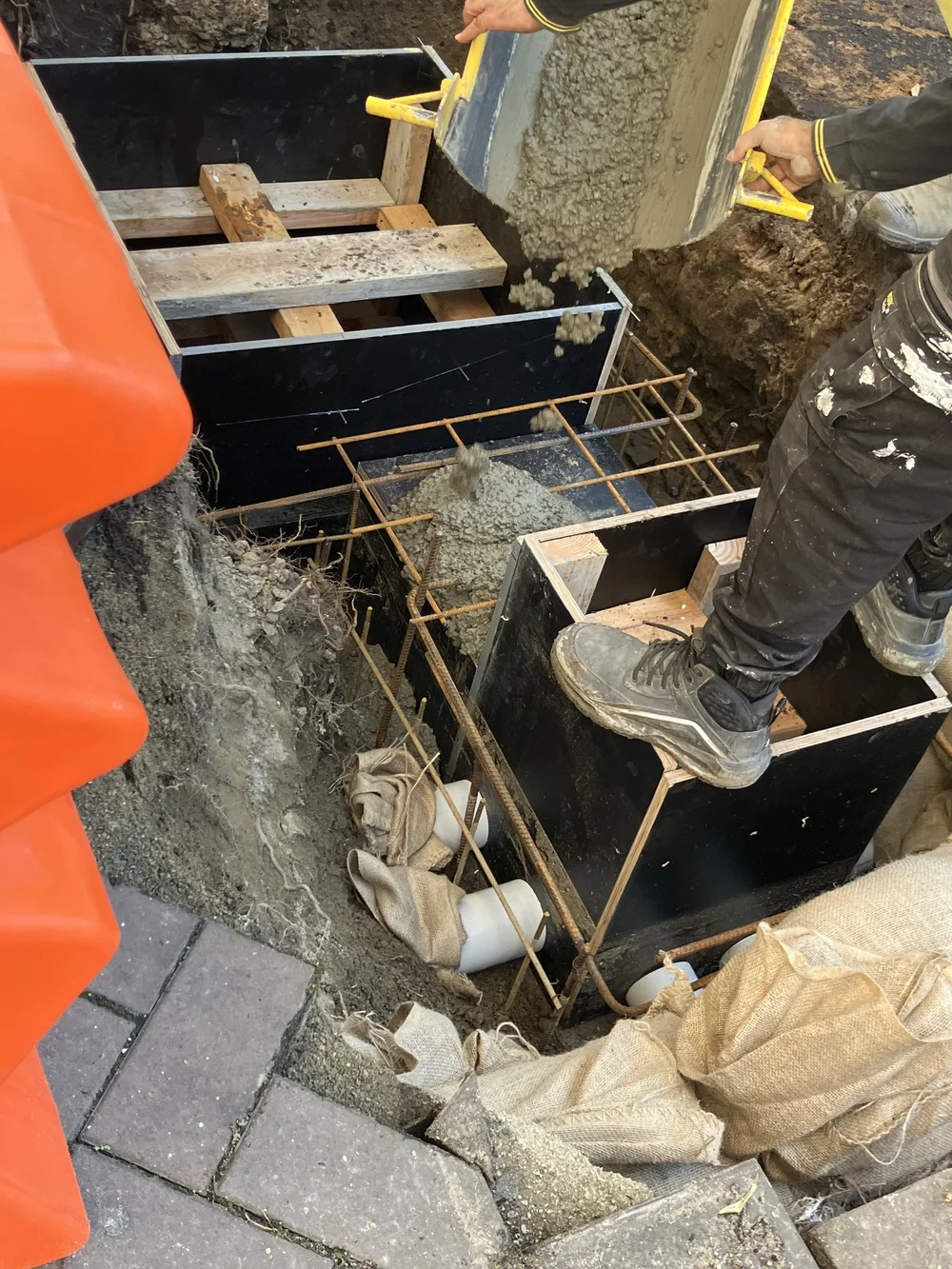
• Concrete truck pouring concrete into the ‘rain garden’ – or, is a more accurate term, “Concrete Garden”?
Key points:
-
Raingardens keep rain where it falls to grow plants, trees, cool streets, reduce pollution
-
Mayor Clover Moore, Sydney City Council, strong supporter of trialling raingardens – thank you
-
Latest replacement raingardens in Chippendale fail in first week’s rainfall
-
Third trial design for four or more raingardens to be built –
-
uses truckloads of concrete and steel
-
Cost estimated at ~1..5 – 2m
-
-
Community observes raingardens in rain, drought and see why they fail
-
No community consultation about the drawings
-
Community designed and built rain gardens and which do work use no concrete, steel
Before concrete was poured and during construction, and days before rain began to fall, some of us from Chippendale who stood near these works could hear water draining into what seemed from the echoing below us to be an existing pit not a new one.
The water seemed to be from the adjoining roof of the large block-wide apartment block that runs between Moorgate Street and Buckland street; that source of water seemed the only explanation for the sound of water running into the pit when there was no water or rain in the gutters to the works site.
Our Chippendale community is researching these works further and another blog may provide some answers and a further explanation of these works.
Concrete pour, July 2025: Video above shows:
-
Six drain pipes in a concrete and steel pit located about 1 metre below ground;
The six pipes are later to be filled with gravel to discharge rainwate to soil about 1 metre below surface and these observations seem applicable:–
-
the six pipes are too deeply placed and too small in diameter to provide water to plants above
-
the pipes will fail as sediment blocks the gravel through which the rain is intended to flow to the soil
-
sediment in the pit needs to be removed by sucker trucks – creatibng ongoing climate pollution and operating costs.
Weir / Spillway does not spill water from one bed to the other
• Instead of spilling water from the upper to the lower bed, the water runs to a pit below and adjacent to the upper and lower beds and goes either or both (it’s unclear at the moment – no practical completion design – works as executed (WAE) review is yet available, the drawings seem ambiguous) to the lower bed or to Sydney harbour. Plants are yet to be planted and the design and / or construction review may be undertaken then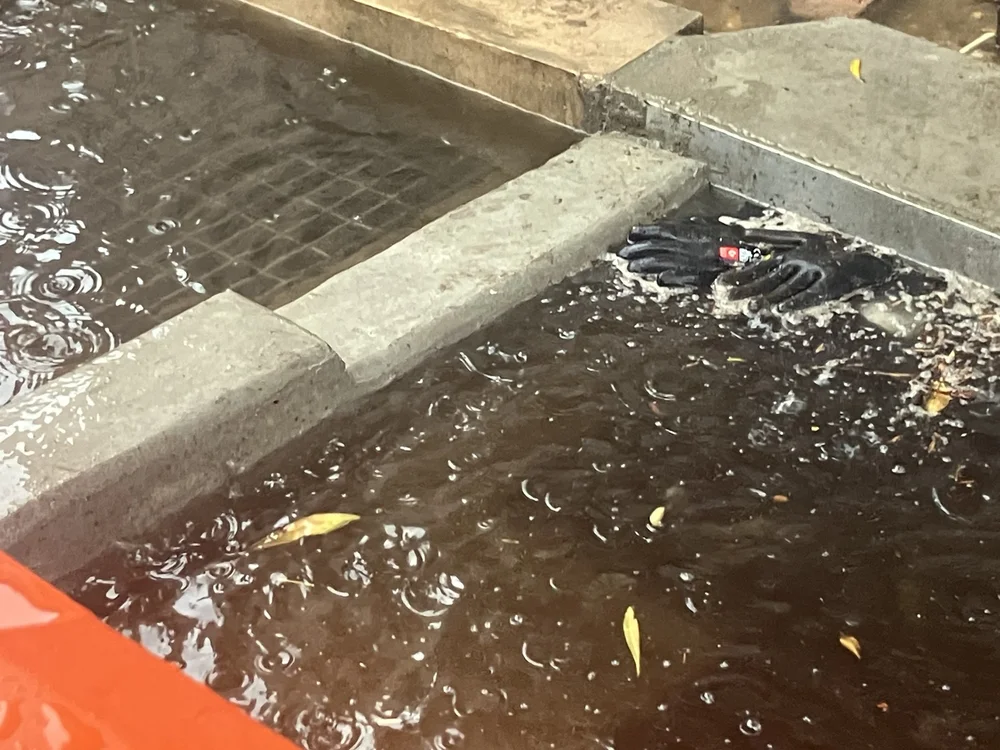
Why is this new work being done?
The Council’s answer to this question is in the drawings, copy below at the end of this blog, and includes these words:
“These raingardens are due for renewal. The filter media and plants need to be replaced.
Raingardens have developed and improved over the years. Where practical renewals should include improvements to bring earlier raingardens closer to current standards.”
• Some re-wording with a splash of humility and a dash of openness; for example, in place of “raingardens are due for renewal”, perhaps, “raingardens did not keep rain where it falls“? And, “We are so confident we’ve got it right this time (whilst using other people’s money – ratepayers’) we see no need to publish our drawings for public comment”.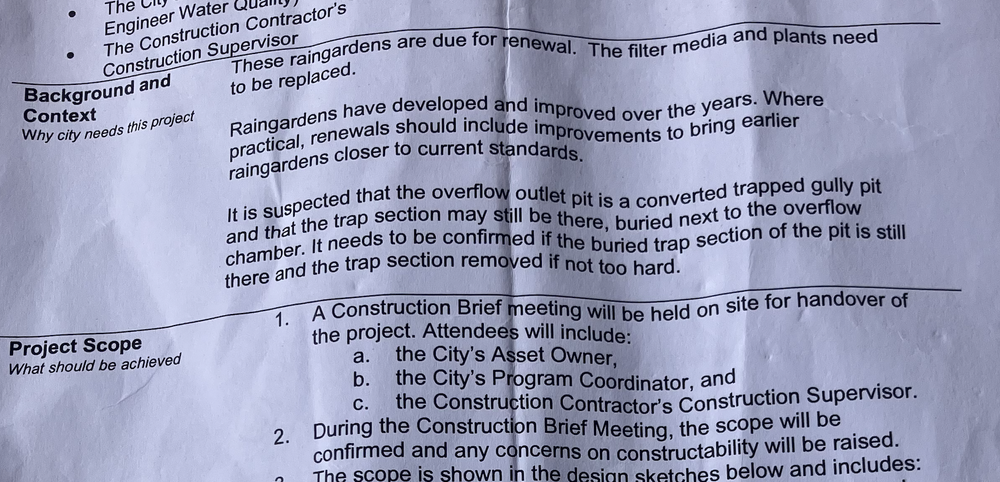
The weir or spillway is a break in the concrete wall where the level of the concrete is lower than the rest of the wall. The purpose of a spillway is to spill water to the next bed where, in an effective rain garden, the overflowing water would be absorbed when the upper bed was flooded.
The spillway does not spill water in the video above which was taken during steady rain.
Does this matter?
In its 2024 financial report Sydney City Council reports spending $1.018B on civil works such as these; see postscript below.
What is a “sustainable” rain garden
Some five or so years ago, around 2019 (?), our Chippendale community made a very simple rain garden without concrete or steel, using recycled materials (bathtub), some new plastic pipe, geofabric-covered agricultural drain pipe.
Capital cost about $25. Operating cost $nil.
The rain garden catches half the rain from the roof of the warehouse and the rain running off the footpath between the warehoue and the raingarden.
Each year about 281,000 litres of rain from the warehouse roof and path is kept in the rain garden.
The other goal of the raingarden design is to express and celebrate the beauty and values of rain when it falls by showing it falling or fountaining from the yellow discharge pipe into the bathtub garden bed.
The ag pipe is buried at the top edge of the bitumen footpath and run around the bottom edge of the concrete gutter – it’s visible in the last moment of the video. The design role of the ag pipes is to catch and disperse below ground rain running off the footpath and any rain running off the bathtub.
Rain has not been observed to overflow to the gutter during the years. It seems the soil is becoming more absorptive as the rain enriches the life and biodiversity in the soil.
A rain garden (also called a “draingarden”) at my house has kept over 2 million litres of water over the last 29 years. It is designed this way:
-
recycled sandstone blocks form three walls beside the 10,000 litre buried concrete rain tank;
-
to enable rain water to flow from the well or pit to adjoining soil on the other side of the pit no concrete or grouting is between the sandstone blocks – the gaps between the block are left for water to flow through;
-
This ‘leaky well’ or rain garden is 1 metre deep and square, and is similar in design to rain gardens built in ancient Persia and by ancient Romans and Greeks – we may see aquaducts and irrigation systems working today, some thousands of years later, for example, if we visit Rome or other ancient cities today;
-
rain overflowing from the rain tank falls by gravity into the draingarden, raingarden, leaky well;
-
as the rain tank overflows and the water in the leaking pit rises the water flows sideways into the adjoining soil and garden;
-
the pit has never overflowed in 29 years.
Operating cost? $nil.
• Leaky well, rain garden, drain garden in my backyard being built of recycled materials in 1996; no concrete, recycled sandstone blocks, no grout – it has never overflowed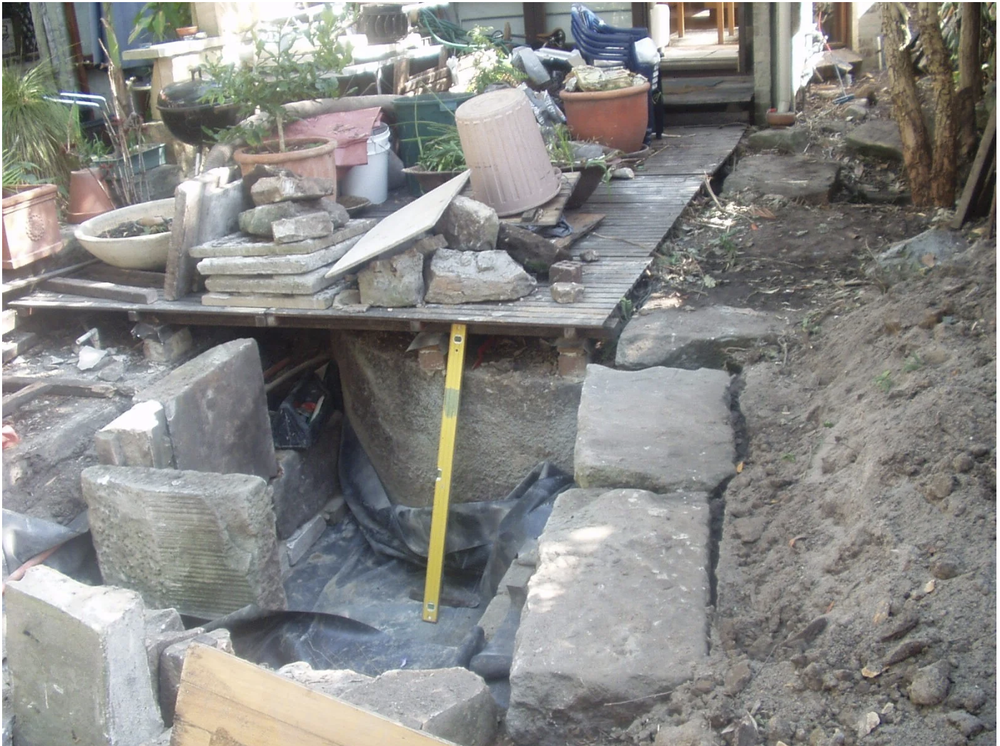
What do the gloves in the photo below say to you?
(Photograph taken 2 August 2025 during several consecutive days of rainfall during which the water may answer those who may look and ask, “What the truth is about these rain gardens? Do they work?” – to which the glove says . . . “No”.)
• 2 August – gloves under water with a couple of fingers above the surface of the water, the gloves and the water have so far gone nowhere.
A glove’s fingers poke up through the water and grate. Do they suggest we change how we design, consult and build raingardens?
What our Chippendale community offers
What we offer is:
-
an invitation to Council to consult with us
-
to find out together there is a better, cheaper way
-
to, if asked, maybe show an alternative design – as part of our Friends of Chippendale Sustainable Precinct plan.
Michael Mobbs
Postscript: the drawings for these works
• What is, “Cost code C2404”?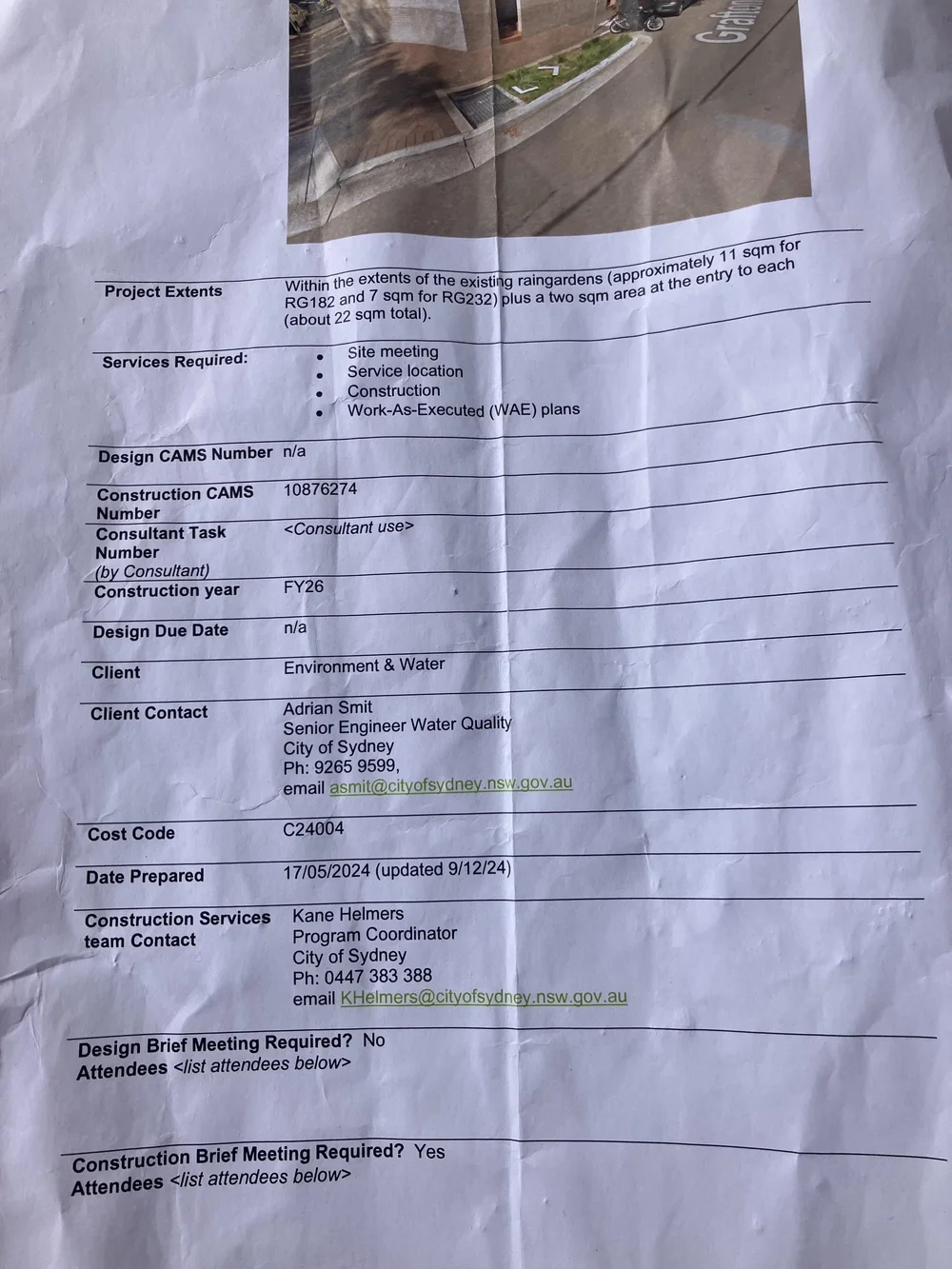
• Council reports spending $1.018B on civil works in 2024

